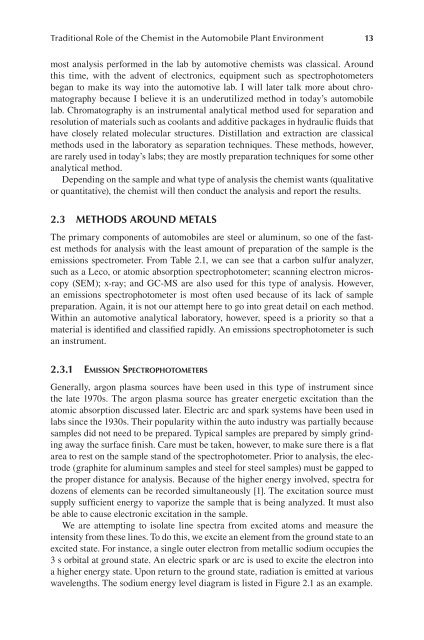THE ROLE OF THE
THE ROLE OF THE
THE ROLE OF THE
Create successful ePaper yourself
Turn your PDF publications into a flip-book with our unique Google optimized e-Paper software.
Traditional Role of the Chemist in the Automobile Plant Environment 13<br />
most analysis performed in the lab by automotive chemists was classical. Around<br />
this time, with the advent of electronics, equipment such as spectrophotometers<br />
began to make its way into the automotive lab. I will later talk more about chromatography<br />
because I believe it is an underutilized method in today’s automobile<br />
lab. Chromatography is an instrumental analytical method used for separation and<br />
resolution of materials such as coolants and additive packages in hydraulic fluids that<br />
have closely related molecular structures. Distillation and extraction are classical<br />
methods used in the laboratory as separation techniques. These methods, however,<br />
are rarely used in today’s labs; they are mostly preparation techniques for some other<br />
analytical method.<br />
Depending on the sample and what type of analysis the chemist wants (qualitative<br />
or quantitative), the chemist will then conduct the analysis and report the results.<br />
2.3 metHods around metals<br />
The primary components of automobiles are steel or aluminum, so one of the fastest<br />
methods for analysis with the least amount of preparation of the sample is the<br />
emissions spectrometer. From Table 2.1, we can see that a carbon sulfur analyzer,<br />
such as a Leco, or atomic absorption spectrophotometer; scanning electron microscopy<br />
(SEM); x-ray; and GC-MS are also used for this type of analysis. However,<br />
an emissions spectrophotometer is most often used because of its lack of sample<br />
preparation. Again, it is not our attempt here to go into great detail on each method.<br />
Within an automotive analytical laboratory, however, speed is a priority so that a<br />
material is identified and classified rapidly. An emissions spectrophotometer is such<br />
an instrument.<br />
2.3.1 Em i s s i o n spEc trophotom E tEr s<br />
Generally, argon plasma sources have been used in this type of instrument since<br />
the late 1970s. The argon plasma source has greater energetic excitation than the<br />
atomic absorption discussed later. Electric arc and spark systems have been used in<br />
labs since the 1930s. Their popularity within the auto industry was partially because<br />
samples did not need to be prepared. Typical samples are prepared by simply grinding<br />
away the surface finish. Care must be taken, however, to make sure there is a flat<br />
area to rest on the sample stand of the spectrophotometer. Prior to analysis, the electrode<br />
(graphite for aluminum samples and steel for steel samples) must be gapped to<br />
the proper distance for analysis. Because of the higher energy involved, spectra for<br />
dozens of elements can be recorded simultaneously [1]. The excitation source must<br />
supply sufficient energy to vaporize the sample that is being analyzed. It must also<br />
be able to cause electronic excitation in the sample.<br />
We are attempting to isolate line spectra from excited atoms and measure the<br />
intensity from these lines. To do this, we excite an element from the ground state to an<br />
excited state. For instance, a single outer electron from metallic sodium occupies the<br />
3 s orbital at ground state. An electric spark or arc is used to excite the electron into<br />
a higher energy state. Upon return to the ground state, radiation is emitted at various<br />
wavelengths. The sodium energy level diagram is listed in Figure 2.1 as an example.







